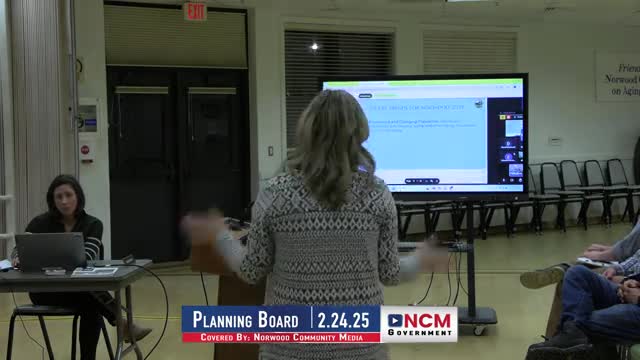Norwood's population growth highlights housing needs and rising affordability challenges
February 26, 2025 | Town of Norwood, Norfolk County, Massachusetts
This article was created by AI summarizing key points discussed. AI makes mistakes, so for full details and context, please refer to the video of the full meeting. Please report any errors so we can fix them. Report an error »

The Planning Board meeting held on February 26, 2025, in Norwood, Massachusetts, focused on key demographic and economic trends impacting the community. The discussions highlighted significant changes in population dynamics, housing affordability, and transportation patterns that are shaping the future of Norwood.
One of the primary topics was the growth and diversification of Norwood's population. The town's population is not only increasing but also aging and becoming more racially diverse. Data presented indicated that the percentage of residents aged 65 and older has risen from approximately 17% in 2010 to nearly 19% in 2020, with projections suggesting this could reach 25% soon. This demographic shift necessitates planning for different housing types and services tailored to older adults.
The meeting also addressed the shrinking household sizes in Norwood, which have implications for housing demand. As household sizes decrease, the need for more housing units increases, even as the overall population grows. This trend is consistent with broader patterns observed across the state and nation.
Housing affordability emerged as a critical concern, particularly for low and middle-income households. Since 2016, the median sales price of single-family homes in Norwood has increased by nearly 30%, while condo prices have surged by almost 60%. With the town's median household income at $98,653 in 2024, many residents face challenges affording housing without exceeding the recommended 30% of their income on housing costs. The data revealed that a household would need to earn over $200,000 annually to comfortably afford a condo, highlighting the affordability crisis in the community.
Economic trends were also discussed, noting Norwood's strong location and infrastructure that support growth. However, there is a notable disparity between where people live and work, with more individuals employed in Norwood than those residing in the town. This trend underscores Norwood's role as a regional job hub, but it also raises questions about commuting patterns and the need for improved transportation options.
The meeting concluded with a focus on enhancing connectivity within Norwood. While the town has good access to transportation, challenges remain in making walking and biking safer and more convenient. The board emphasized the importance of considering environmental justice in future planning, ensuring equitable access to open spaces and amenities for all residents.
Overall, the discussions at the Planning Board meeting underscored the need for proactive planning to address the evolving demographic landscape, housing affordability, and transportation challenges in Norwood. The insights gained will inform future policies and initiatives aimed at fostering a sustainable and inclusive community.
One of the primary topics was the growth and diversification of Norwood's population. The town's population is not only increasing but also aging and becoming more racially diverse. Data presented indicated that the percentage of residents aged 65 and older has risen from approximately 17% in 2010 to nearly 19% in 2020, with projections suggesting this could reach 25% soon. This demographic shift necessitates planning for different housing types and services tailored to older adults.
The meeting also addressed the shrinking household sizes in Norwood, which have implications for housing demand. As household sizes decrease, the need for more housing units increases, even as the overall population grows. This trend is consistent with broader patterns observed across the state and nation.
Housing affordability emerged as a critical concern, particularly for low and middle-income households. Since 2016, the median sales price of single-family homes in Norwood has increased by nearly 30%, while condo prices have surged by almost 60%. With the town's median household income at $98,653 in 2024, many residents face challenges affording housing without exceeding the recommended 30% of their income on housing costs. The data revealed that a household would need to earn over $200,000 annually to comfortably afford a condo, highlighting the affordability crisis in the community.
Economic trends were also discussed, noting Norwood's strong location and infrastructure that support growth. However, there is a notable disparity between where people live and work, with more individuals employed in Norwood than those residing in the town. This trend underscores Norwood's role as a regional job hub, but it also raises questions about commuting patterns and the need for improved transportation options.
The meeting concluded with a focus on enhancing connectivity within Norwood. While the town has good access to transportation, challenges remain in making walking and biking safer and more convenient. The board emphasized the importance of considering environmental justice in future planning, ensuring equitable access to open spaces and amenities for all residents.
Overall, the discussions at the Planning Board meeting underscored the need for proactive planning to address the evolving demographic landscape, housing affordability, and transportation challenges in Norwood. The insights gained will inform future policies and initiatives aimed at fostering a sustainable and inclusive community.
View full meeting
This article is based on a recent meeting—watch the full video and explore the complete transcript for deeper insights into the discussion.
View full meeting
